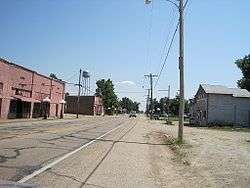Black Oak, Arkansas
- This is about the town in Craighead County. For the unincorporated community in Washington County, see Black Oak, Washington County, Arkansas. For the band, see Black Oak Arkansas.
| Black Oak, Arkansas | |
|---|---|
| Town | |
 | |
 Location in Craighead County and the state of Arkansas | |
| Coordinates: 35°50′11″N 90°22′3″W / 35.83639°N 90.36750°WCoordinates: 35°50′11″N 90°22′3″W / 35.83639°N 90.36750°W | |
| Country | United States |
| State | Arkansas |
| County | Craighead |
| Area | |
| • Total | 0.5 sq mi (1.2 km2) |
| • Land | 0.5 sq mi (1.2 km2) |
| • Water | 0 sq mi (0 km2) |
| Elevation | 230 ft (70 m) |
| Population (2010) | |
| • Total | 262 |
| • Density | 585/sq mi (226.0/km2) |
| Time zone | Central (CST) (UTC-6) |
| • Summer (DST) | CDT (UTC-5) |
| ZIP code | 72414 |
| Area code(s) | 870 |
| FIPS code | 05-06610 |
| GNIS feature ID | 0076365 |
Black Oak is a town in Craighead County, Arkansas, United States. The population was 262 at the 2010 census.[1] It is included in the Jonesboro, Arkansas Metropolitan Statistical Area. Black Oak is the setting of John Grisham's novel A Painted House.
Geography
Black Oak is located in eastern Craighead County at 35°50′11″N 90°22′3″W / 35.83639°N 90.36750°W (35.836510, -90.367504).[2] It is 20 miles (32 km) east of Jonesboro, the county seat, and 4 miles (6 km) south of Monette.
According to the United States Census Bureau, the town has a total area of 0.4 square miles (1.0 km2), all land.
List of highways
Demographics
| Historical population | |||
|---|---|---|---|
| Census | Pop. | %± | |
| 1930 | 302 | — | |
| 1940 | 329 | 8.9% | |
| 1950 | 261 | −20.7% | |
| 1960 | 220 | −15.7% | |
| 1970 | 272 | 23.6% | |
| 1980 | 309 | 13.6% | |
| 1990 | 277 | −10.4% | |
| 2000 | 286 | 3.2% | |
| 2010 | 262 | −8.4% | |
| Est. 2015 | 262 | [3] | 0.0% |
2014 Estimate[5] | |||
As of the census[6] of 2000, there were 286 people, 120 households, and 81 families residing in the town. The population density was 641.3 inhabitants per square mile (245.4/km²). There were 132 housing units at an average density of 296.0 per square mile (113.3/km²). The racial makeup of the town was 97.55% White, 0.35% Black or African American, 0.70% Native American, 0.70% Asian, 0.70% from other races. 0.70% of the population were Hispanic or Latino of any race.
There were 120 households out of which 24.2% had children under the age of 18 living with them, 59.2% were married couples living together, 5.0% had a female householder with no husband present, and 31.7% were non-families. 28.3% of all households were made up of individuals and 18.3% had someone living alone who was 65 years of age or older. The average household size is 2.38 and the average family size is 2.94.
In the town the population was spread out with 20.3% under the age of 18, 6.6% from 18 to 24, 25.9% from 25 to 44, 24.5% from 45 to 64, and 22.7% who are 65 years of age or older. The median age was 42 years. For every 100 females there were 111.9 males. For every 100 females age 18 and over, there were 98.3 males.
The median income for a household in the town was $22,353, and the median income for a family was $32,917. Males had a median income of $26,042 versus $20,833 for females. The per capita income for the town was $13,237. 17.5% of the population and 10.7% of families were below the poverty line. Out of the total population, 27.1% of those under the age of 18 and 16.7% of those 65 and older were living below the poverty line.
Notable people
Black Oak is the hometown of the founding members of the 1970s Southern rock band Black Oak Arkansas.
John Grisham attended first grade at Black Oak Elementary School for one semester, and his novel A Painted House is set in Black Oak and the surrounding area.
Other communities named "Black Oak"
There are two other, smaller, communities in Arkansas named Black Oak. One is in Washington County about 8 miles (13 km) southeast of Fayetteville. The other is in Poinsett County about 5 miles (8 km) south of Marked Tree. The DeLorme atlas of Arkansas suggests these two hamlets are little more than crossroads.
References
| Wikimedia Commons has media related to Black Oak, Arkansas. |
- ↑ "Geographic Identifiers: 2010 Demographic Profile Data (G001): Black Oak town, Arkansas". U.S. Census Bureau, American Factfinder. Retrieved June 18, 2014.
- ↑ "US Gazetteer files: 2010, 2000, and 1990". United States Census Bureau. 2011-02-12. Retrieved 2011-04-23.
- ↑ "Annual Estimates of the Resident Population for Incorporated Places: April 1, 2010 to July 1, 2015". Retrieved July 2, 2016.
- ↑ "Census of Population and Housing". Census.gov. Archived from the original on May 11, 2015. Retrieved June 4, 2015.
- ↑ "Annual Estimates of the Resident Population for Incorporated Places: April 1, 2010 to July 1, 2014". Retrieved June 4, 2015.
- ↑ "American FactFinder". United States Census Bureau. Archived from the original on 2013-09-11. Retrieved 2008-01-31.


